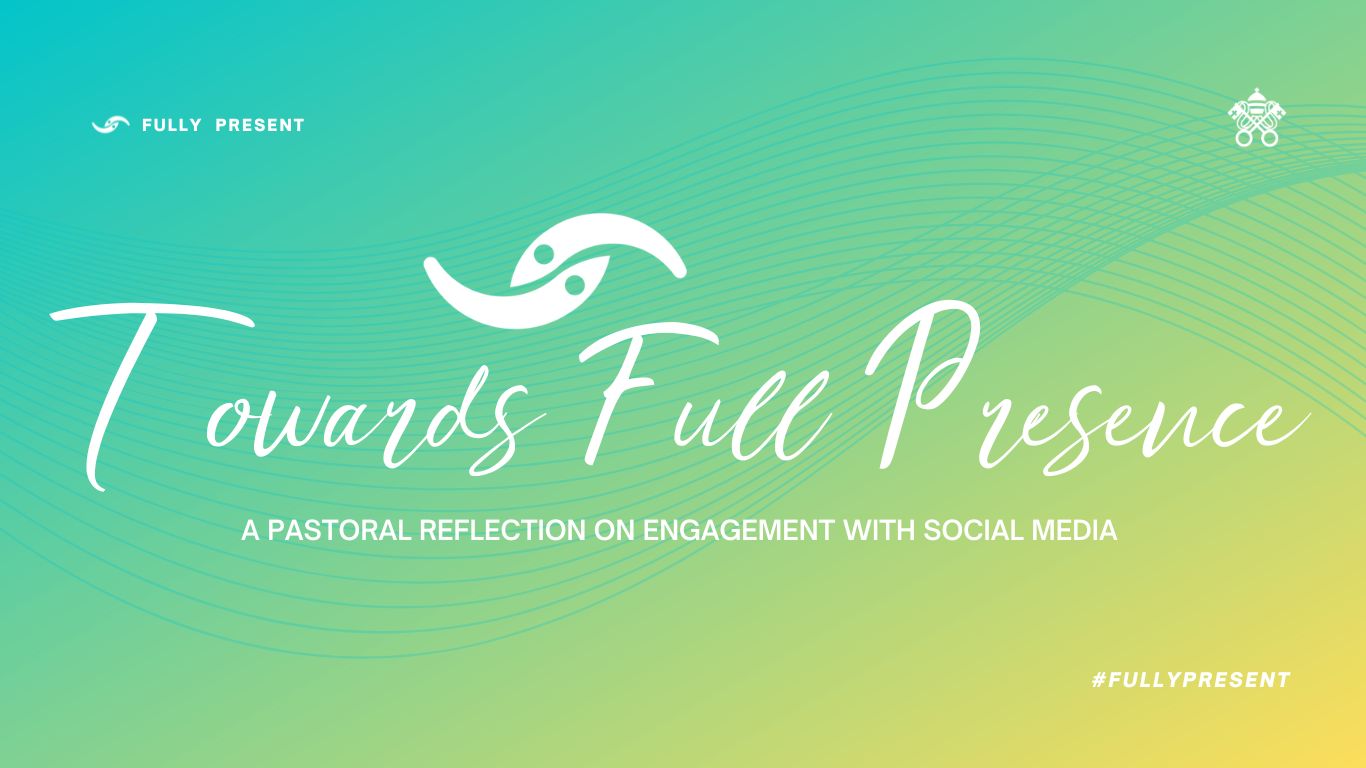

Towards Full Presence: the Opportunity of “Onlife” Existence
Matthew Neugebauer
Thursday, June 15, 2023

Image Courtesy of the Dicastery for Communication.
Towards Full Presence, the recent pastoral reflection from the Dicastery for Communication, weighs in on the pitfalls and opportunities of social media in today's world. Of course, the phrase "social media in today's world" is a slight misnomer. The document's most significant recognition is that the relationships and communities that many people experience online are not merely supplementary to their in-person relationships, but fully integrated components of their lives. It’s fair to say that social media is today's world.
The reflection lays out this recognition near the beginning:
Our culture is now a digital culture. To overcome the old dichotomy between “digital” versus “face to face,” some no longer speak of “online” versus “offline” but only of “onlife,” incorporating human and social life in its various expressions, be they in digital or physical spaces. Well beyond the act of using social media as a tool, we are living in an ecosystem shaped at its core by the experience of social sharing. We turn to social media for a sense of belonging and affirmation, transforming it into a vital space where the communication of core values and beliefs takes place. (#9, 10)Later on, it quotes from Pope Francis' Message for the 48th World Communications Day to describe this "onlife" integration:
The digital world can be an environment rich in humanity; a network not of wires but of people,” if we remember that on the other side of the screen there are no “numbers” or mere “aggregates of individuals.” but people who have stories, dreams, expectations, sufferings. There is a name and a face. (#47)
Distinctions and connections
It’s not that in-person and digital realities should be fused into an amorphous blob. Such an undifferentiated life risks pulling people in the digital-only direction, collapsing themselves into a purely online existence that neglects the fundamental human need for embodied presence. The reflection’s authors call us, as social beings, Christians, and Church communities, to distinguish and relate the ways we interact digitally with our in-person relationships. The rubber hits the road in this need to distinguish and relate digital to in-person when it comes to family and communal eating generally, and the Eucharistic meal in particular. In a section devoted to both family and Sacramental meals, the reflection acknowledges that livestream Mass and other online gatherings “offered some comfort to those who could not participate in person” during the height of the pandemic. (#59) In the introduction, it recalls Pope Francis’ Moment of Prayer in March 2020, just as covid-19 began to sweep across the world. His prayer, message, and Eucharistic Benediction reached 16 million viewers live online, demonstrating the power of digital media to inspire, console, and in a real way, gather the Faithful before God. (#5, fn 6) The lesson of the last three years is that virtual hang-outs and online Mass are meant to be a part of our relationships and connection to Church, not replace the necessity of physical presence. On the one hand, “The use of the social web is complementary to an encounter in the flesh that comes alive through the body, heart, eyes, gaze, and breath of the other.“ (#47, quoting Pope Francis’ Message for the 53rd World Communications Day) On the other hand, “virtual church” has a way of limiting our “full, conscious, and active participation,” or making it feel more optional, especially when we’re alone at home. Now that the coronavirus “no longer qualifies as a global emergency,” Towards Full Presence is free to recall that,All our senses are engaged when we share a meal: taste and smell, glances that contemplate the faces of the diners, listening to the conversations at table. Sharing a meal at table is our first education in attention to others, a fostering of relationships among family members, neighbours, friends, and colleagues. Likewise, we participate with the whole person at the altar: mind, spirit, and body are involved. The liturgy is a sensory experience; we enter into the Eucharistic mystery through the doors of the senses that are awakened and fed in their need for beauty, meaning, harmony, vision, interaction and emotion. Above all, the Eucharist is not something that we can just “watch;” it is something that truly nourishes us. (#61)However, this distinction between in-person and virtual liturgy is more of a qualification rather than the main point. The strength of Towards Full Presence is the authoritative embrace of social media and digital experience as a real "place" where ministry, community, and mission can happen, alongside and as extensions of in-person ministry. Billions of people are now so used to connecting with others online, in some deeply intimate and important ways, that it's an essential part of how they exist in the world.
Why is this recognition significant?
We often say that the Church "thinks in centuries.” We’re right to commend the sober, slow way that Tradition and Church practices often evolve. Sometimes, however, a change in society, life, or culture requires a quicker response. With this reflection, a Vatican Dicastery has acknowledged a reality that didn't exist two decades ago. The Holy See’s communications arm has earnestly sought to “scrutinize the signs of the times and interpret them in the light of the Gospel.” (Gaudium et Spes #4) Its “scrutiny” or “reading” in this case was fairly rigorous, with a broad syllabus, “involving experts, teachers, young professionals and leaders, lay persons, clergy, and religious.” (#5) The discernment found in Towards Full Presence continues the Magisterium’s overall task of "weighing in" on this epoch-defining trend in society, and reminding us that God's "style" of "closeness, tenderness, and compassion" is just as needed in our digital interactions as it always has been in every other ministry context. (#64, with fn 39 citing the “many occasions [General Audiences, the Angelus, Homilies, Press Conferences, etc.]” in which “Pope Francis has spoken about God’s style.”) As such, it encourages leaders of the faithful, many of them “digital immigrants,” to express God’s “style” in the integrated onlife reality experienced by so many people. I think many of us know the personal and pastoral impact of a Church leader seeing us and our experiences on a small scale. “The hope” of this reflection, on a global or at least regional scale, “is to promote a common reflection about our digital experiences, encouraging both individuals and communities to take a creative and constructive approach that can foster a culture of neighbourliness.” (#5) As always, and in the case of this pastoral reflection especially, its true impact will be seen in its response and reception. In my next reflection, I’ll look to the heart of Towards Full Presence, the way it addresses social media influencers and all the baptized as pastoral leaders in the digital space.Related Articles:
<<
SUPPORT LABEL
$50
$100
$150
$250
OTHER AMOUNT
DONATE
Receive our newsletters
Stay Connected
Receive our newsletters

Stay Connected









